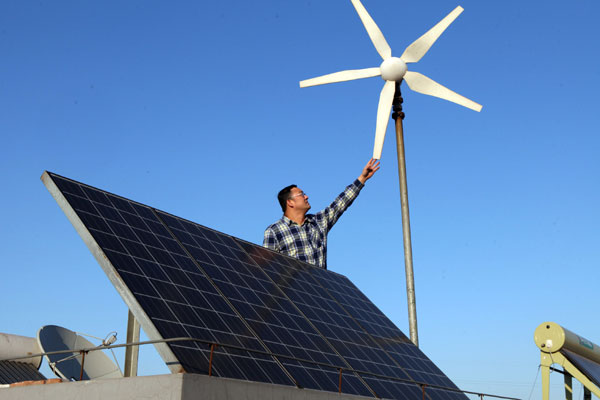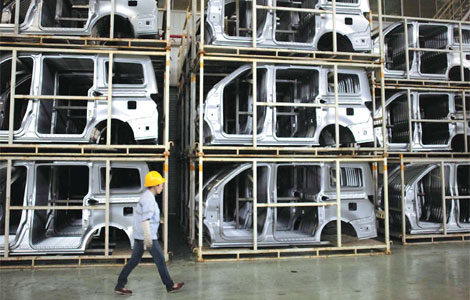Generating interest in homegrown power
Updated: 2013-06-14 07:36
By Zhao Yinan (China Daily)
|
|||||||||||
A new installation at a home in one of China's largest ports could herald an upsurge in domestic use of new energy, as Zhao Yinan reports from Tianjin.
 |
|
Dong Qiang checks the PV cells on the roof of his home in Tianjin. [Photo by Wang Huan / for China Daily] |
Dong Qiang's neighbors have suddenly become very friendly. Although the 38-year-old knew his neighbors by sight, they have never before paid him a visit. Now, however, they have started to descend on him in droves.
The reason? The "big screens" Dong recently installed on his roof.
The "big screens" are photovoltaic, or PV, cells that generate electricity for domestic use by harnessing solar power. Each panel is roughly the same size as a four-seater dining table and Dong expects the system to reduce his carbon emissions by as much as five metric tons every year.
It's little wonder that Dong's new appliances have attracted so much attention: several silicon batteries affixed to the roof mean the house, in Tianjin's Binhai New Area, stands out among the other dwellings in the area.
He also is the first resident of Tianjin, a harbor city in Northern China and one of the country's four municipalities, to decide to go green on the roof of his own home.
Dong said he received feedback from the power supplier, Tianjin Binhai Electricity Co, in March, just a week after he filed an application to install the panels, which are more correctly known as distributed PV generators.
Dong's new equipment, which has been in operation for two months, was connected to China's national electricity network in late May.
"The grid company sent a team of mechanics to my house to assess its suitability to host a household solar power plant. They installed a new meter to record the power generation capacity, and that was that," he said, adding that the procedure was much less difficult and time-consuming than he had anticipated.
"It was much easier than I thought. Generating power at home for one's own use is still a novel thing in China. I thought they would probably have reservations about approving my application, but it all went pretty smoothly."
Dong, who works for a power distribution equipment manufacturer, invested about 65,000 yuan ($10,596) on the infrastructure, which includes 3 kW of PV panels and 3 kW of wind power turbines. "I hope to recoup the investment in 10 or 12 years," he said.
Inspiring the neighbors
Dong's decision has inspired many living near his modified, eye-catching house.
Li Jiansheng, who lives in the building next to Dong's home, visited his neighbor after the unusual facility was set up almost directly above his head.
"I was concerned at first. I wondered if his roof could support the weight of the panels and whether the facility might be dangerous during thunder and lightning storms. But Dong showed me the equipment and explained the method of operation. I was pleased to see that a lightning rod had been attached."
Li was surprised to learn that, in addition to being environmentally friendly, Dong's project has also resulted in a business opportunity; the solar panels are connected to the national network, which means any surplus electricity generated can be automatically transmitted to the public power network. The grid company will pay 0.41 yuan for each kWh of electricity it receives from Dong's set-up, a price determined by Tianjin's municipal government.
Encouraged by their neighbor's initiative, Li and two other local residents have applied to Tianjin Binhai Electricity Co to install their own distributed PV generators and are dealing with the preliminary paperwork.
"The method was absolutely new to me. Although the price is pretty high, I still think it's an attractive proposition to help large families or small and medium-sized companies reduce their daily expenses," Li said.
Related Stories
Poor transmission facilities block new energy use: expert 2013-05-06 10:58
'New energy': Shining title for a traditional production paradigm 2013-05-06 07:13
Low charge in new-energy initiative 2013-04-08 07:59
New policies support new energy cars 2013-03-25 16:58
New-energy policies boost for Tianjin auto makers 2013-03-08 21:14
New-energy cars to help cut emissions in Beijing 2013-03-05 17:12
Today's Top News
China gives approval to GM soybeans
EU files WTO dispute on steel measures
EU seeks WTO ruling over steel measures
Nation's rise a common goal across Straits
Astronauts into space module
Li urges further Ethiopian ties
US should 'explain hacking activity'
Chinese continue leaving Ghana
Hot Topics
Lunar probe , China growth forecasts, Emission rules get tougher, China seen through 'colored lens', International board,
Editor's Picks

|

|

|

|

|

|





